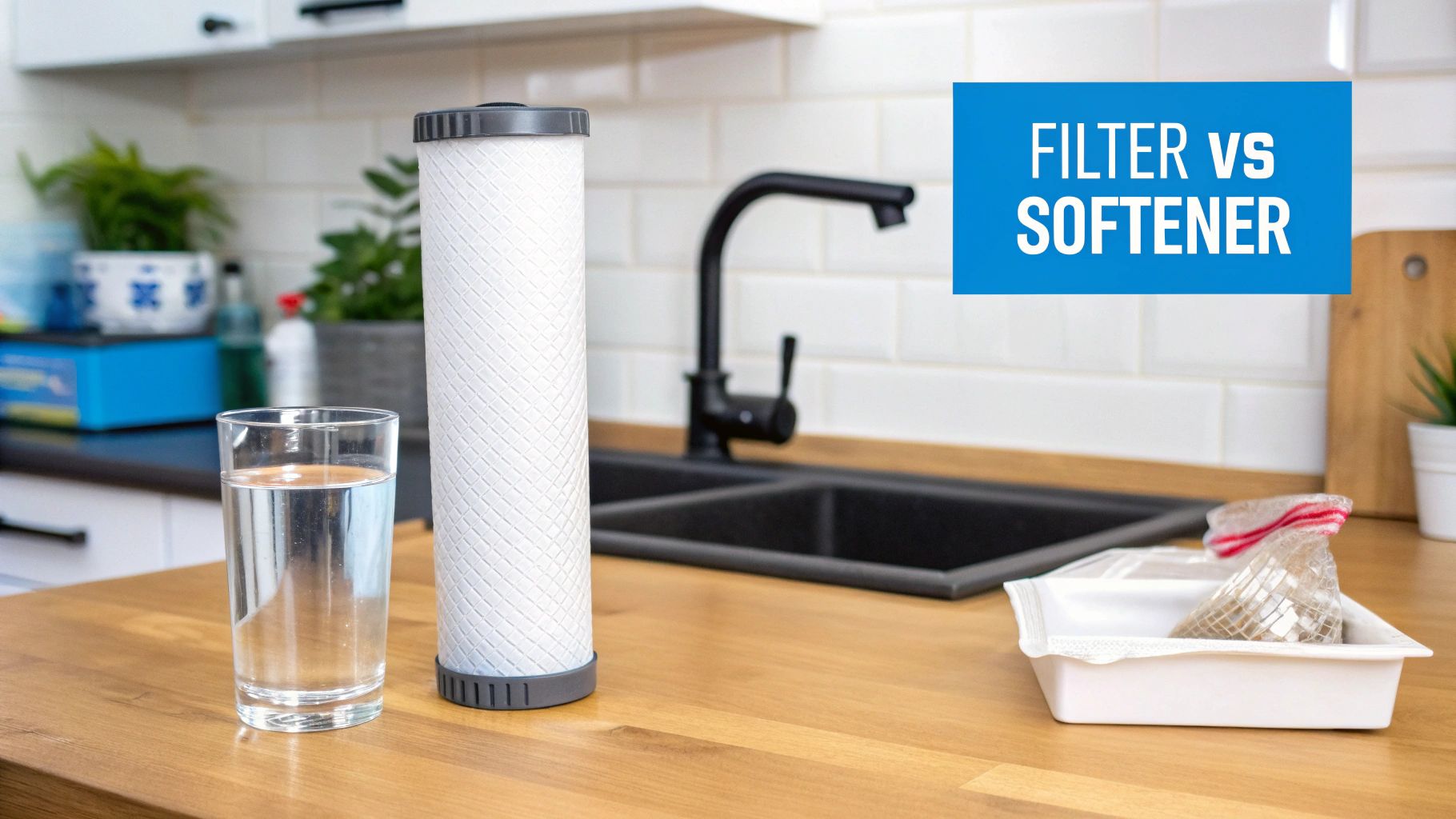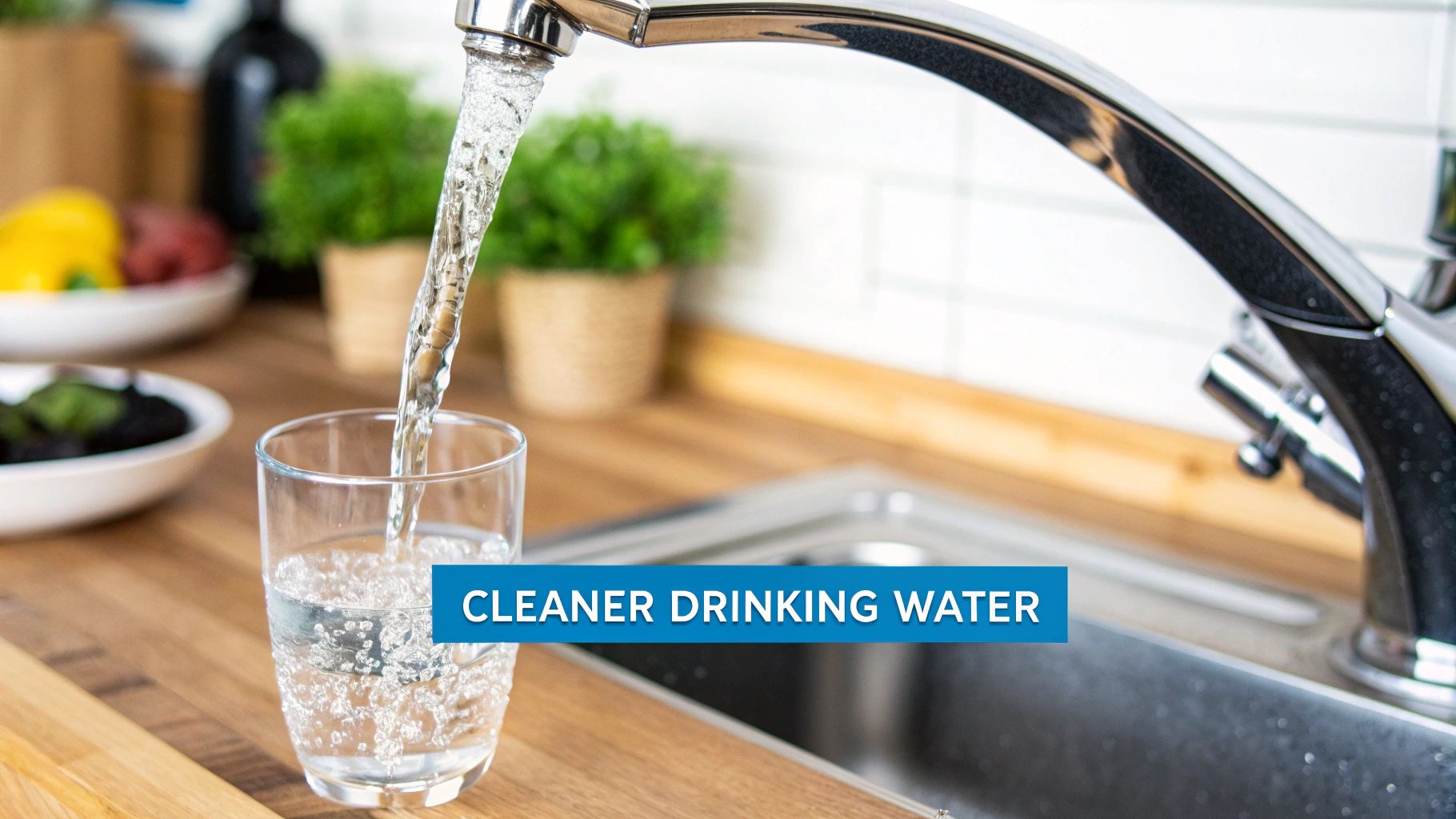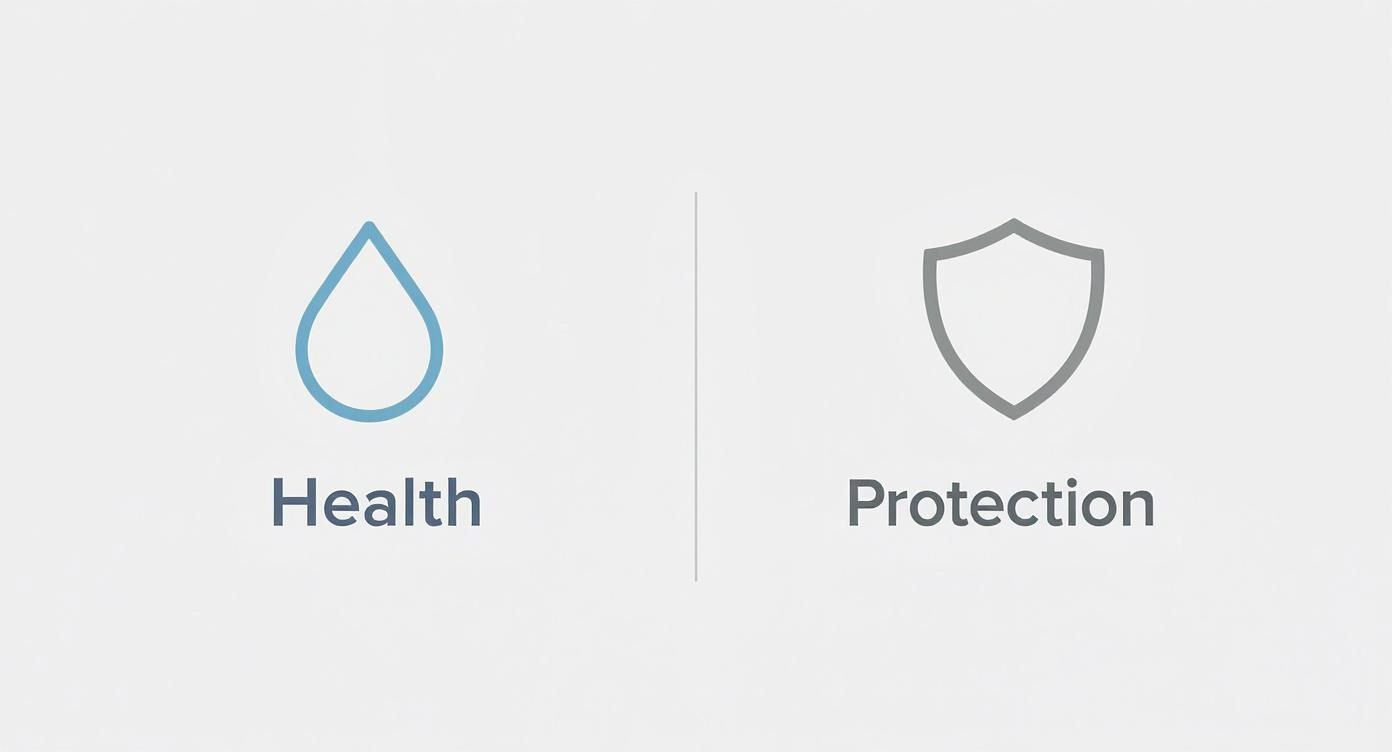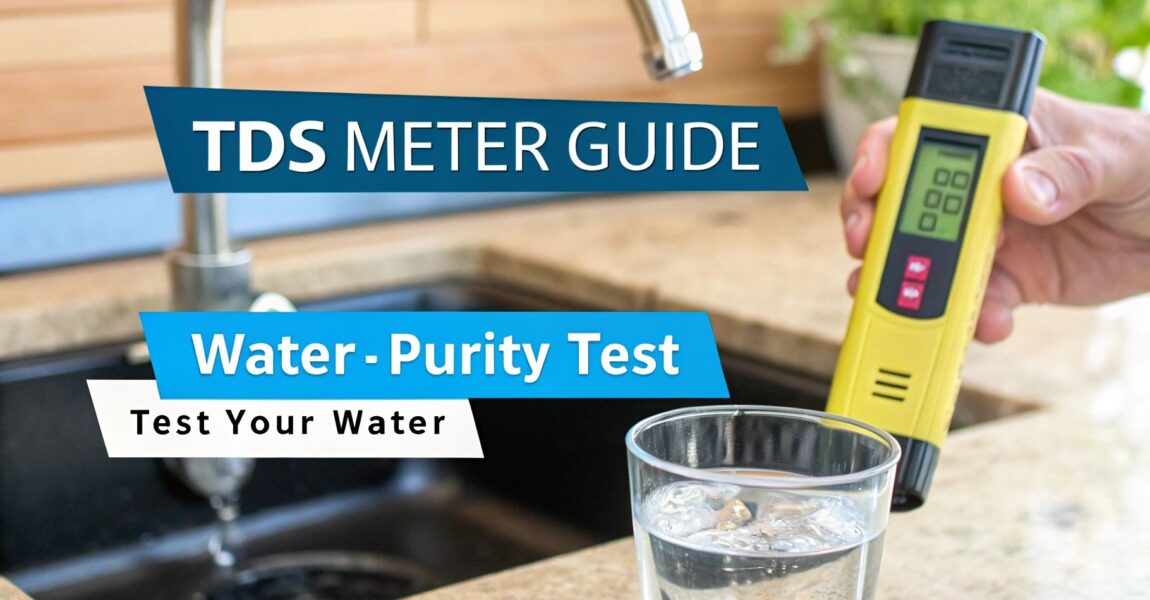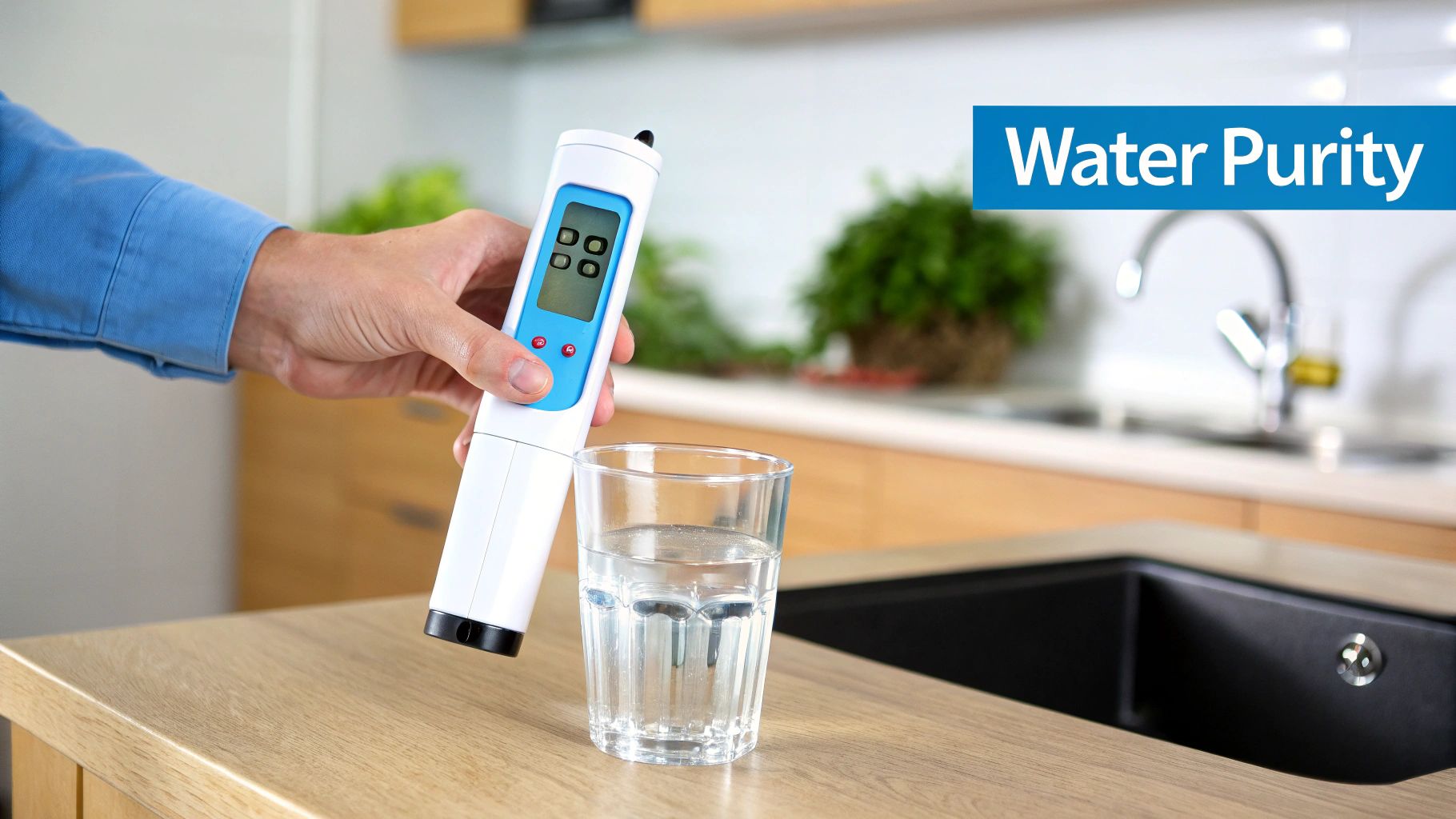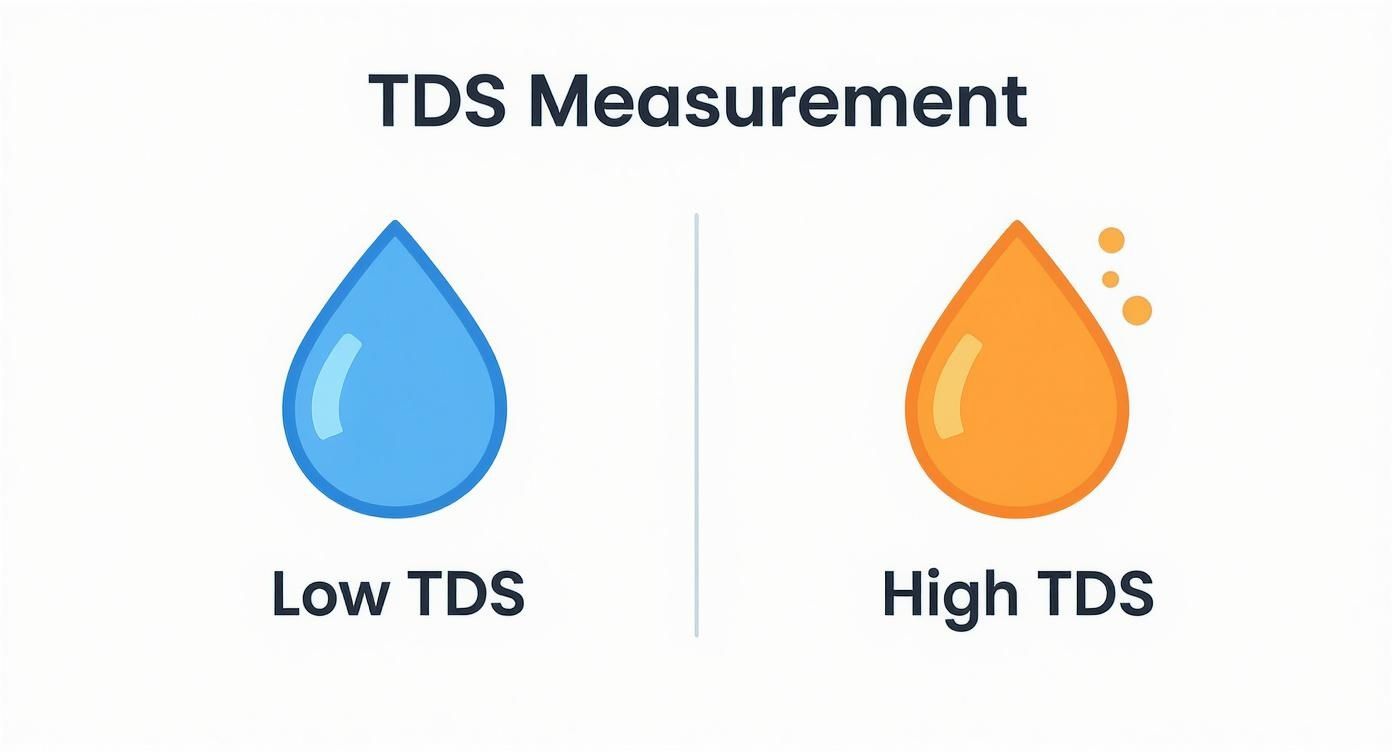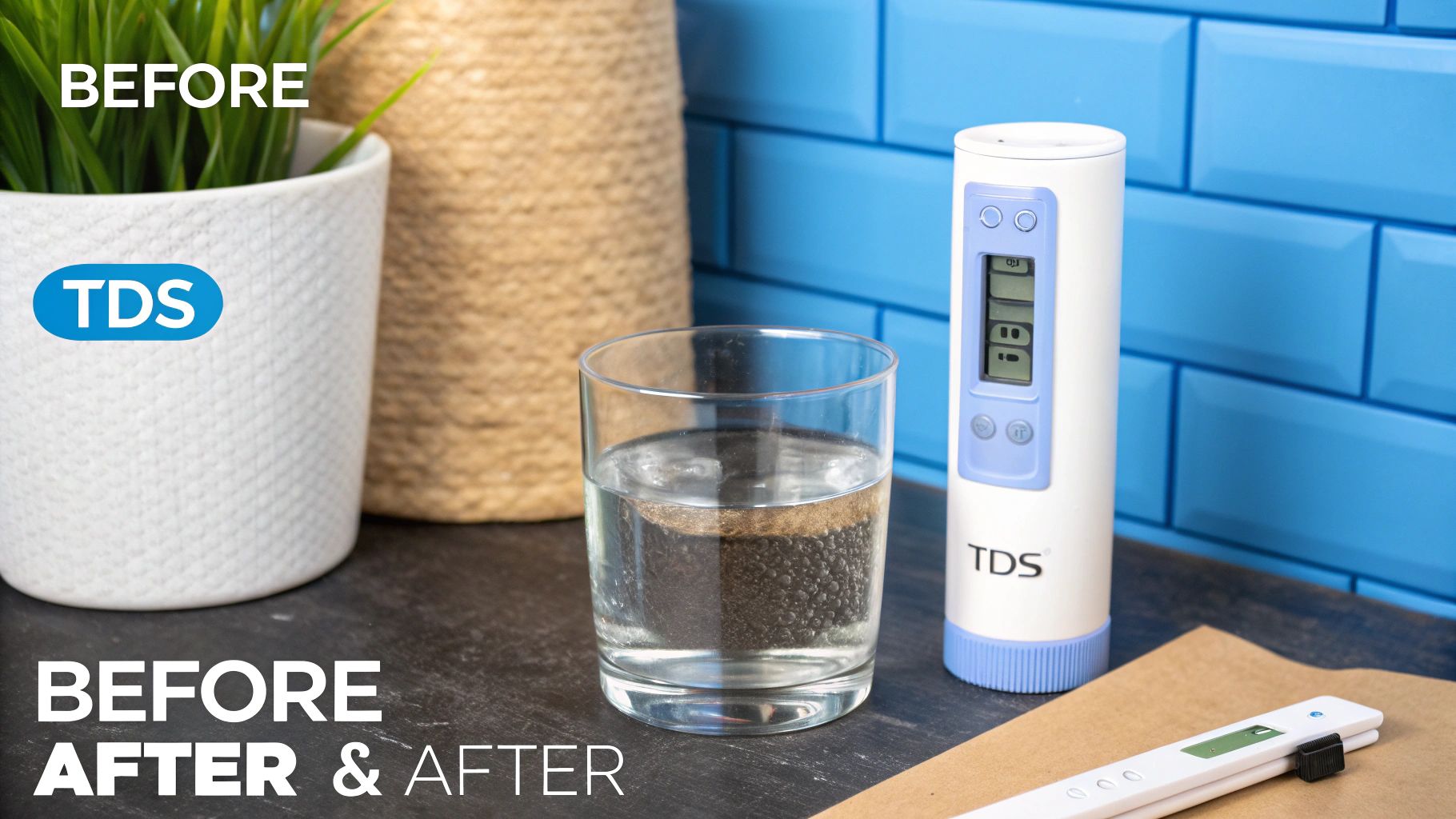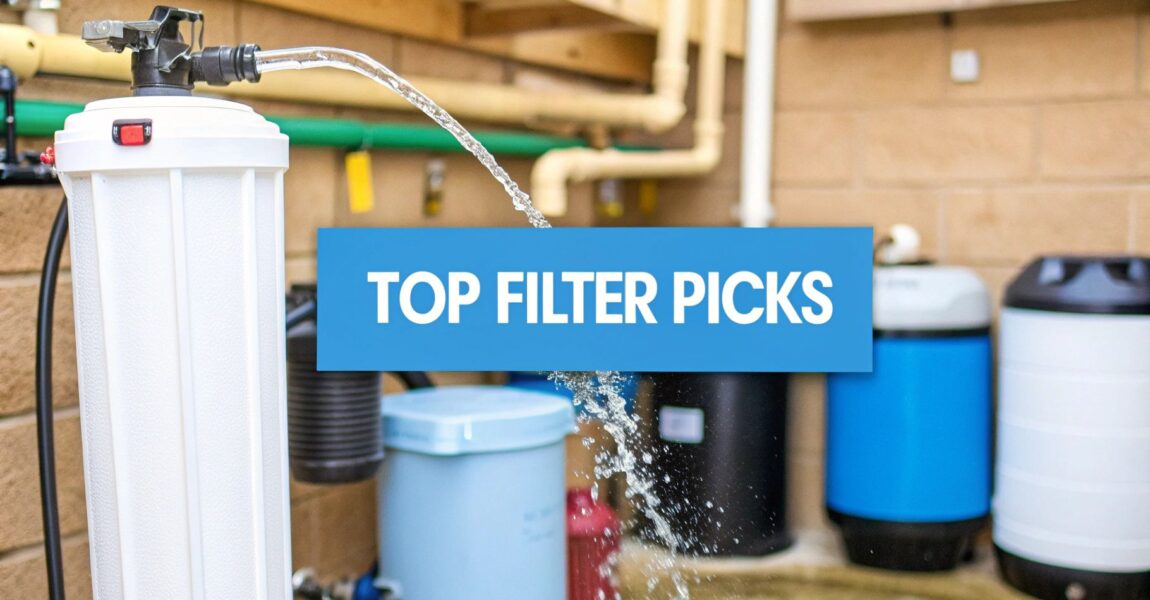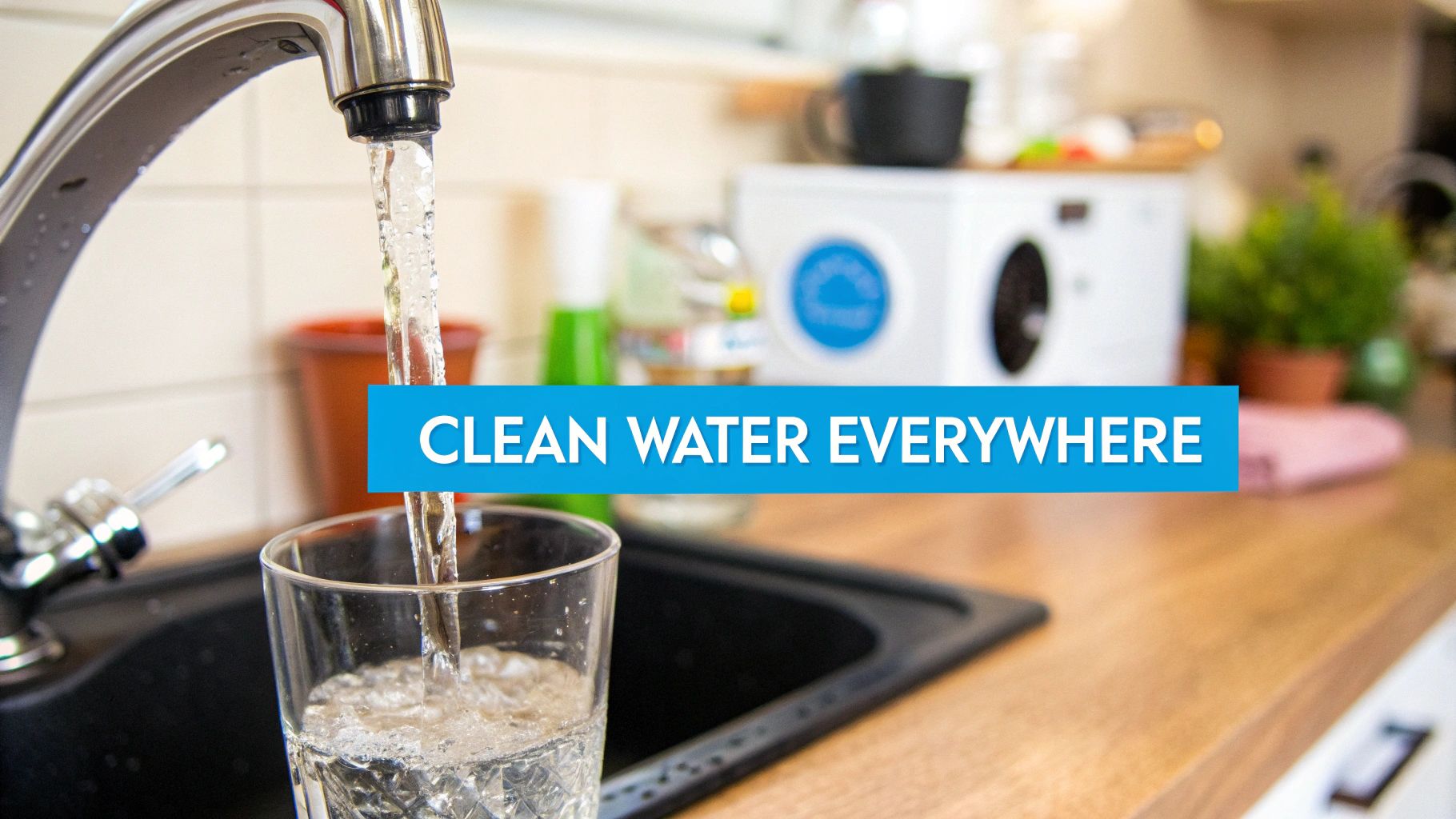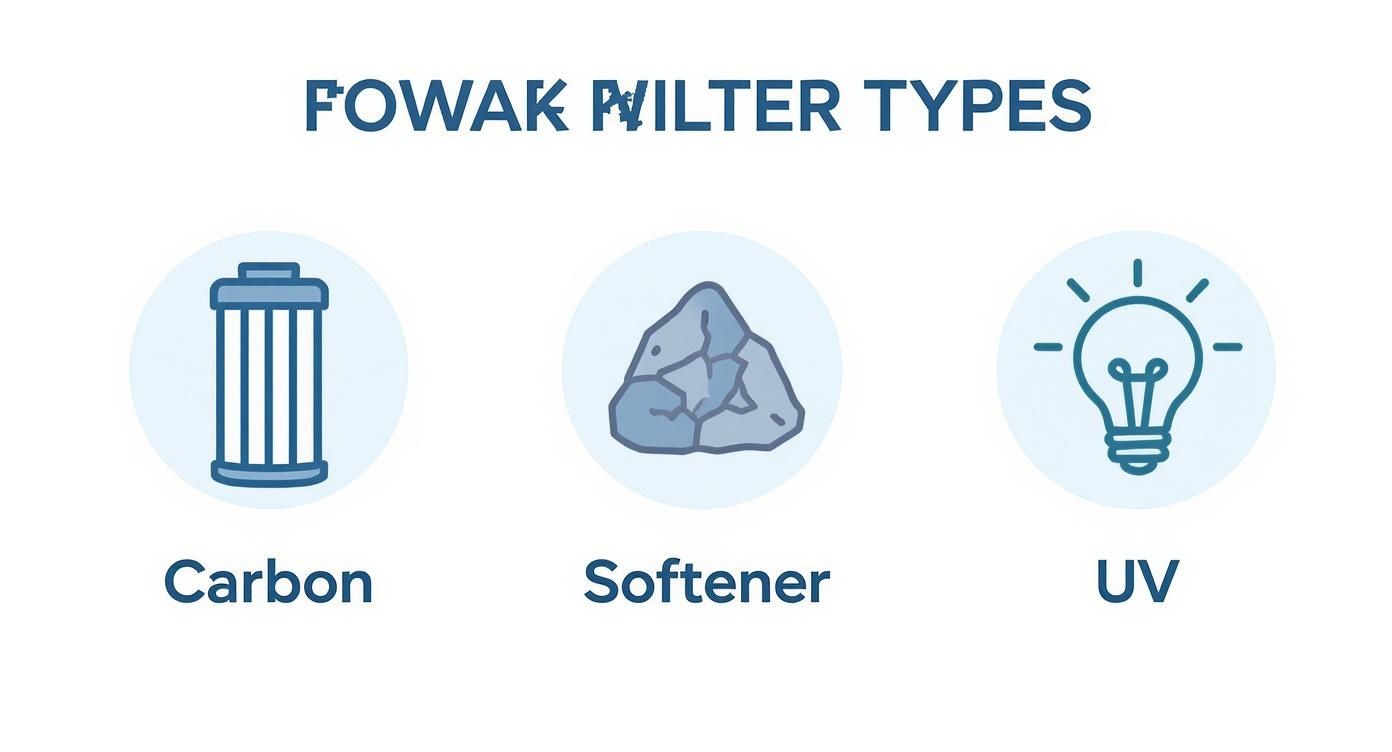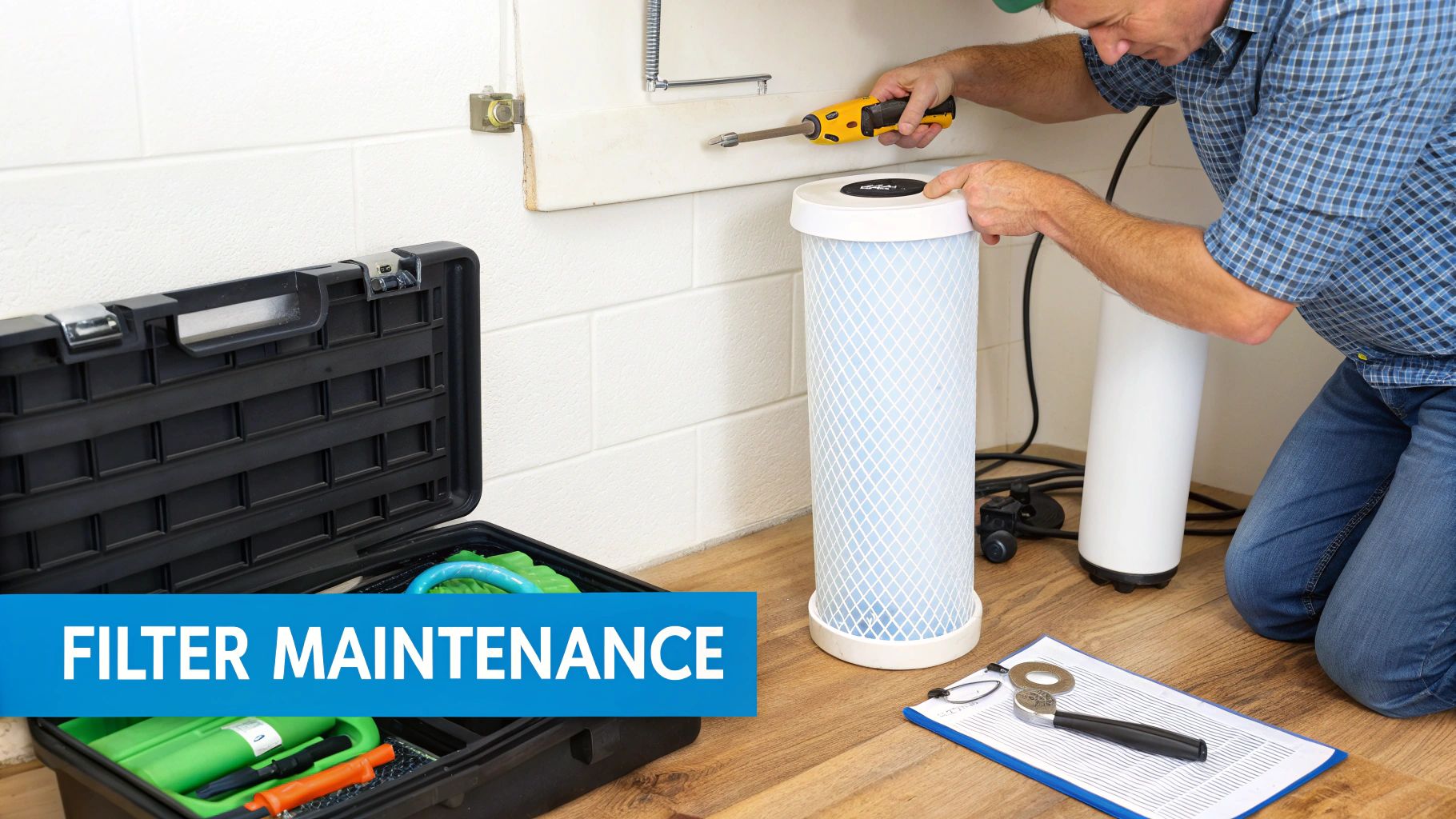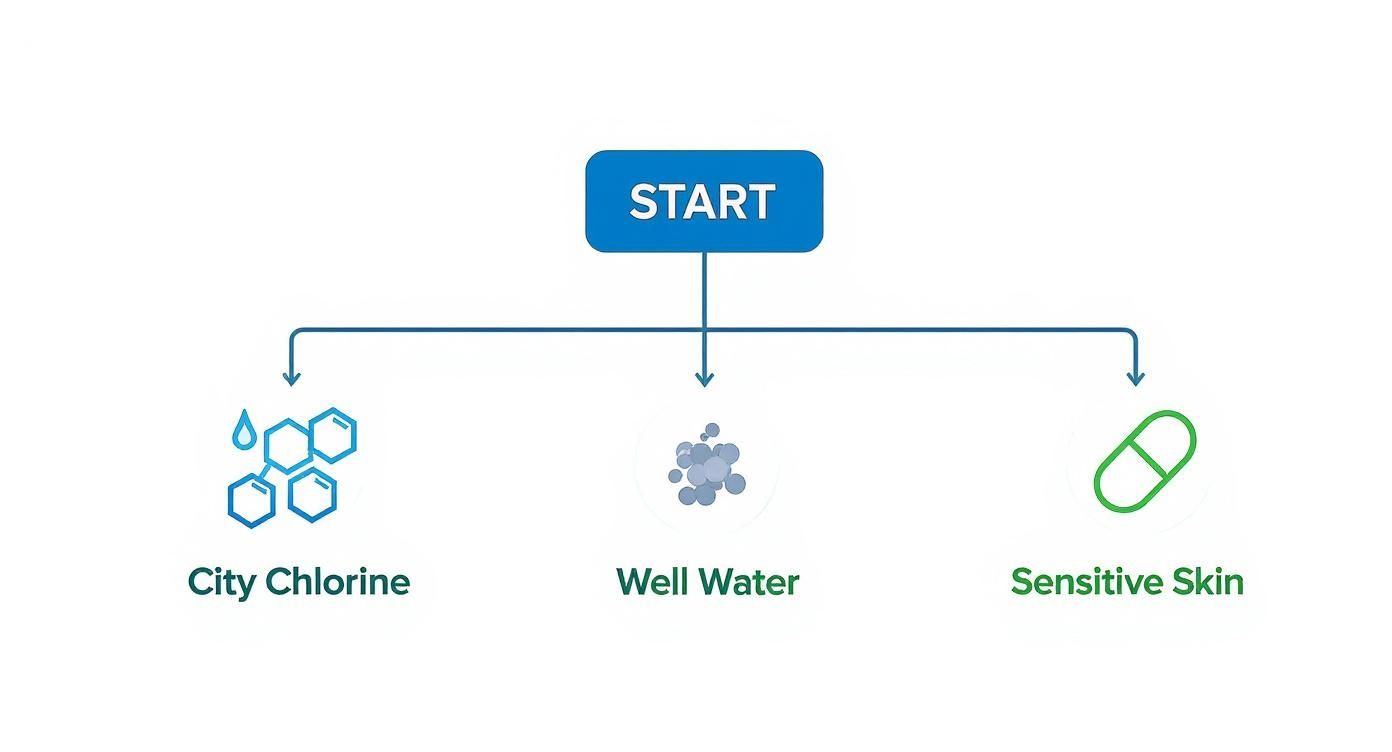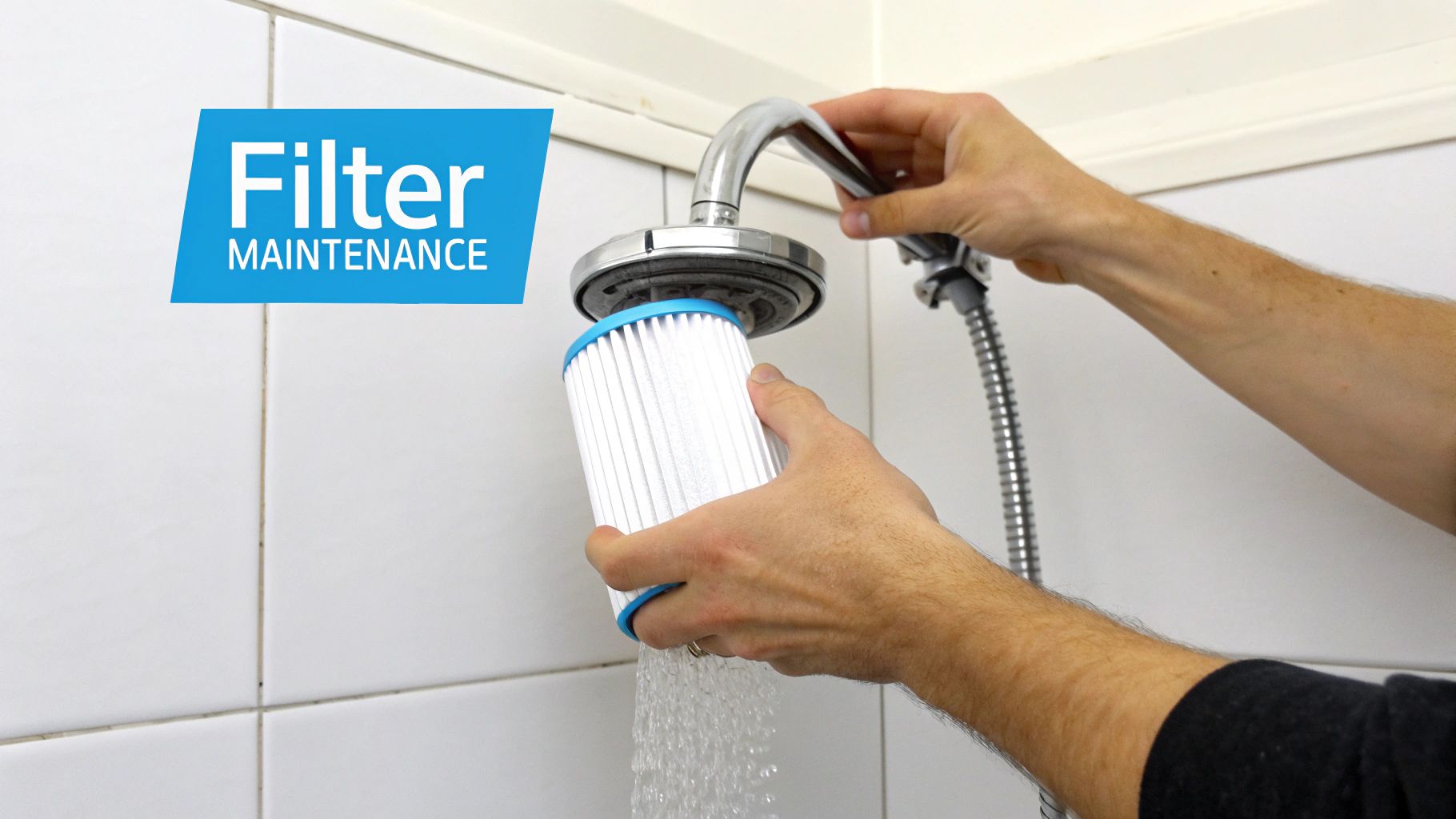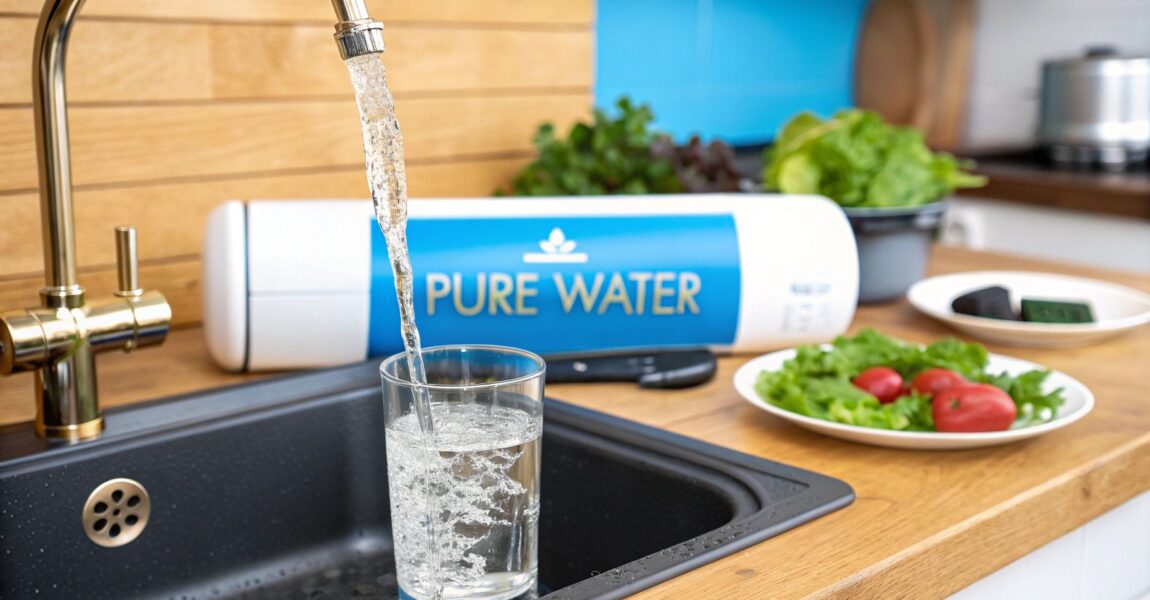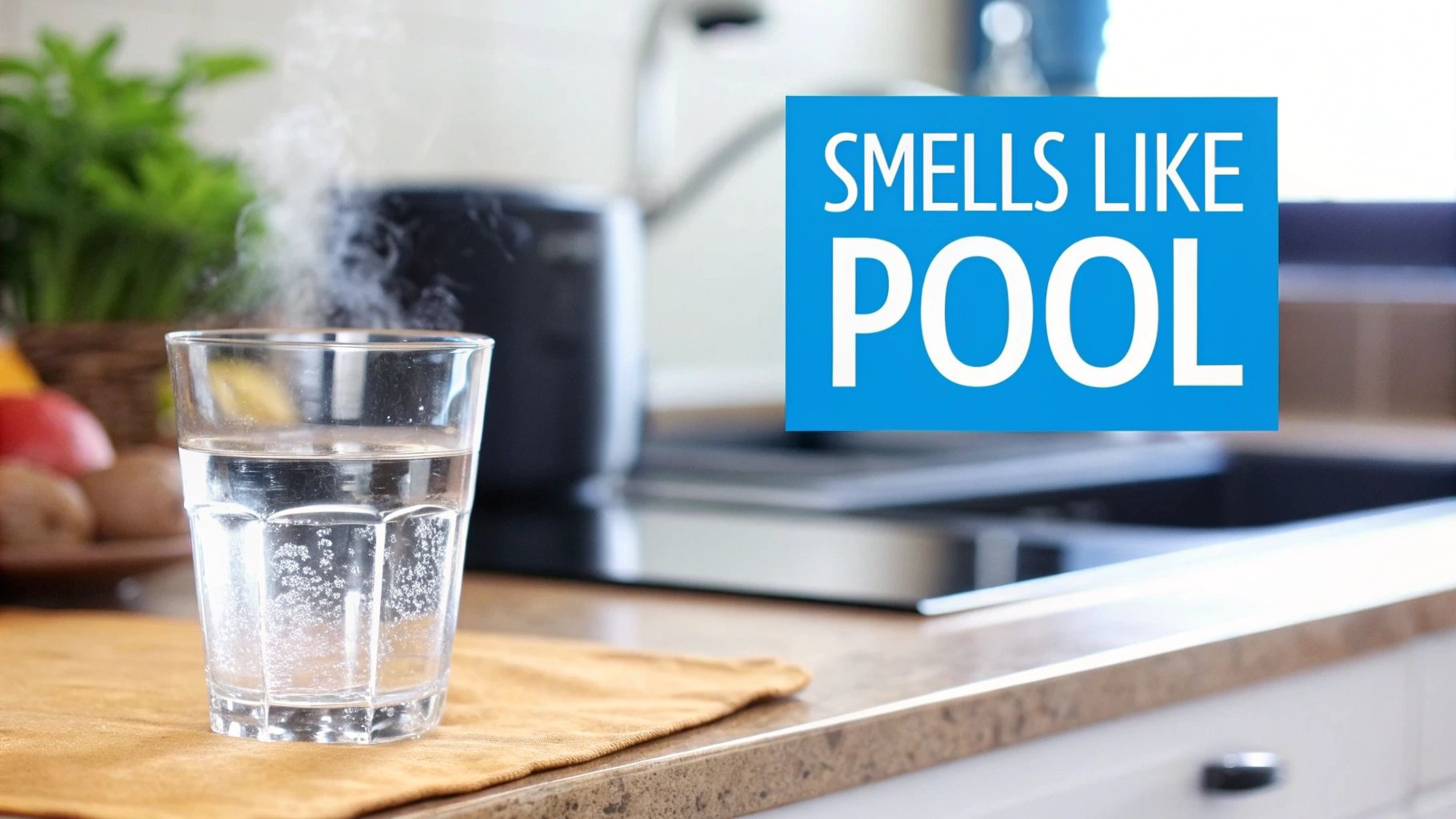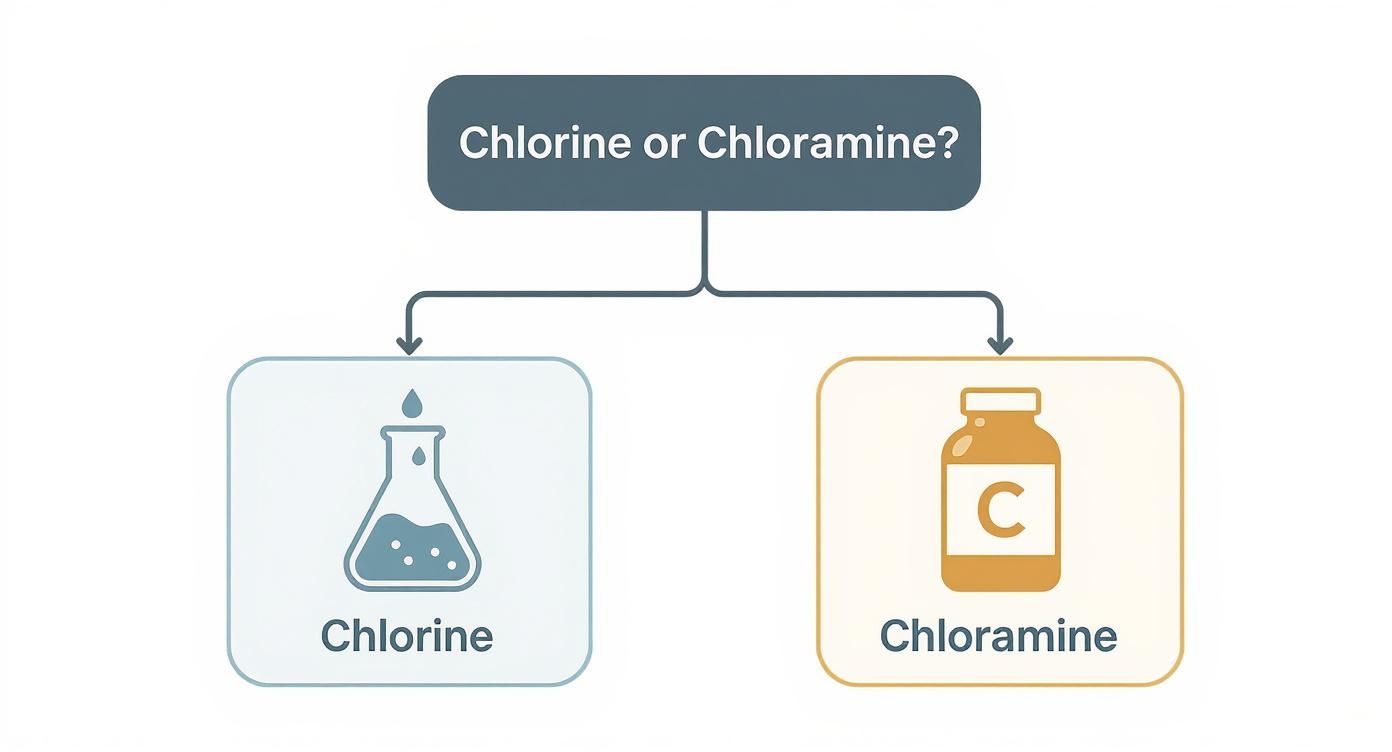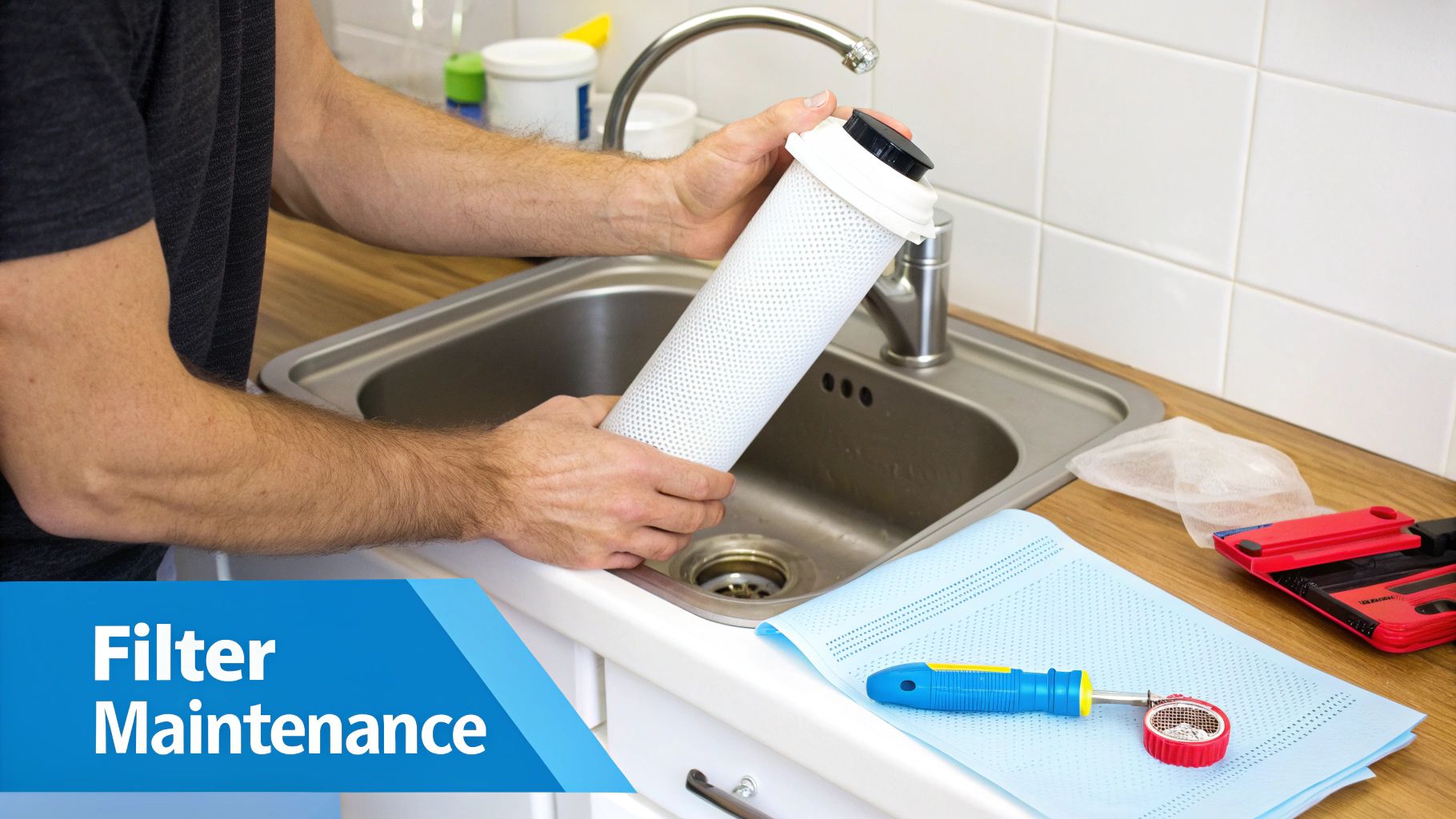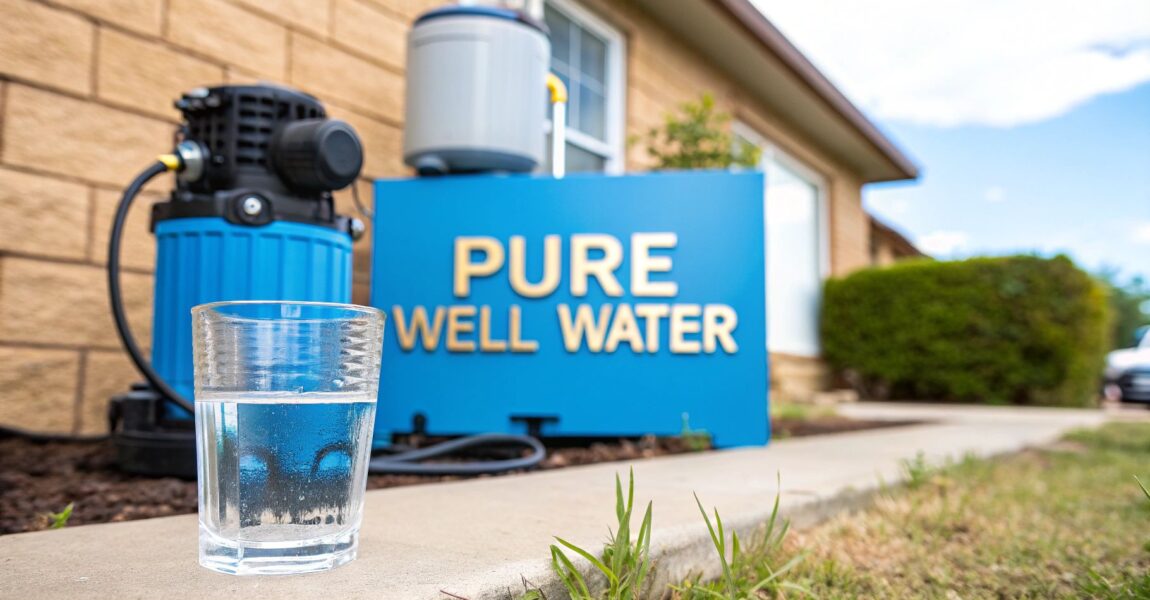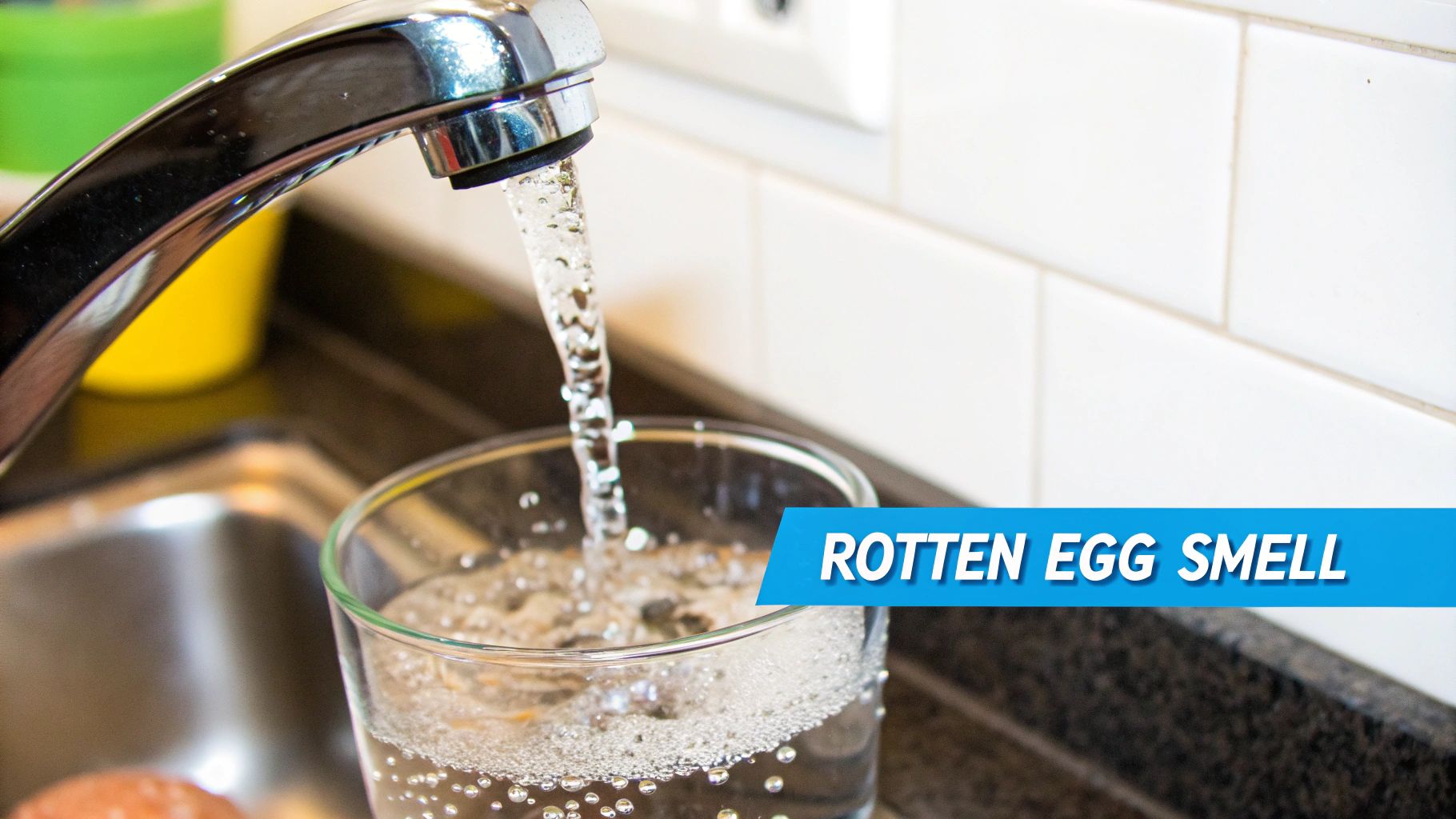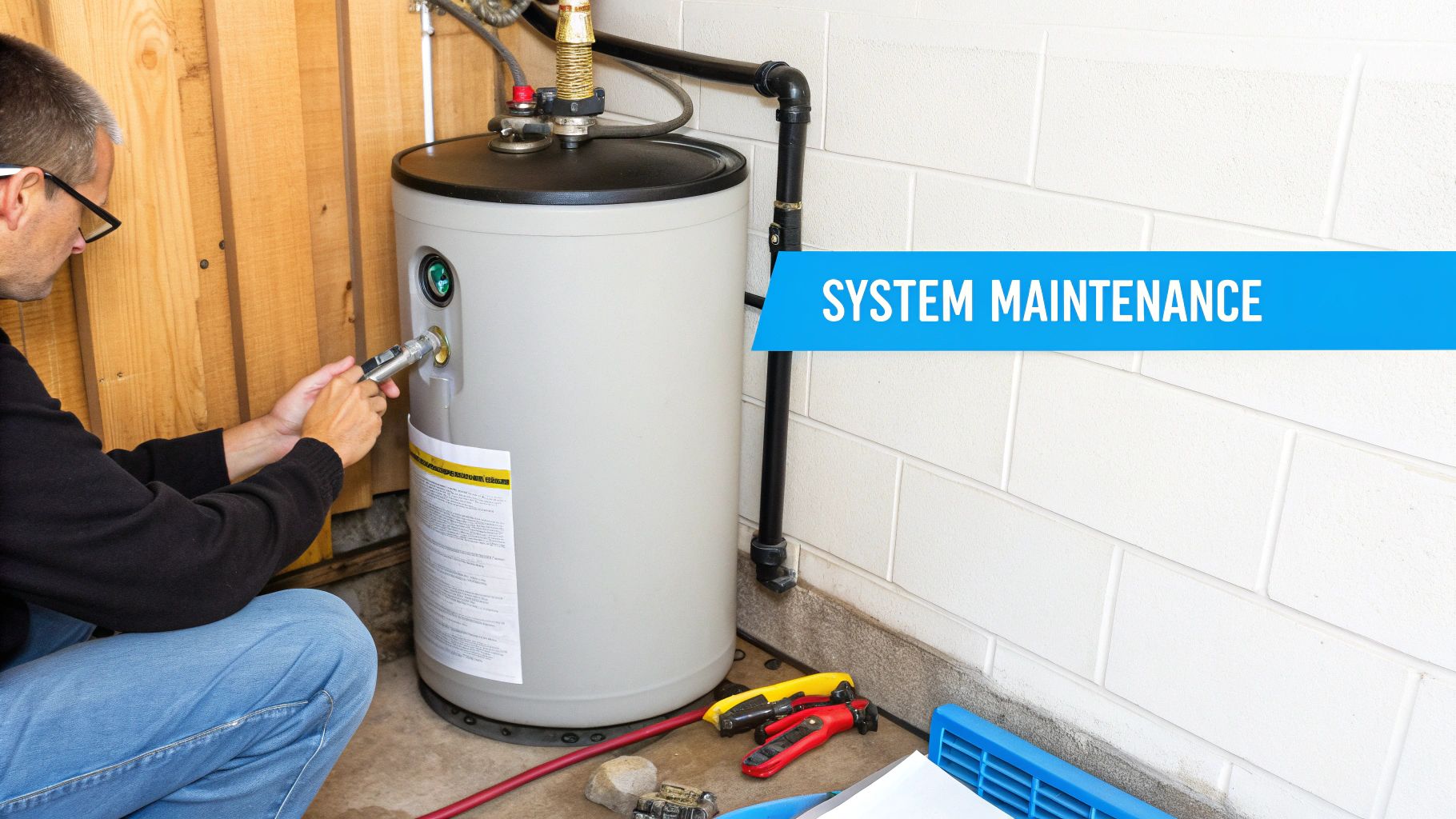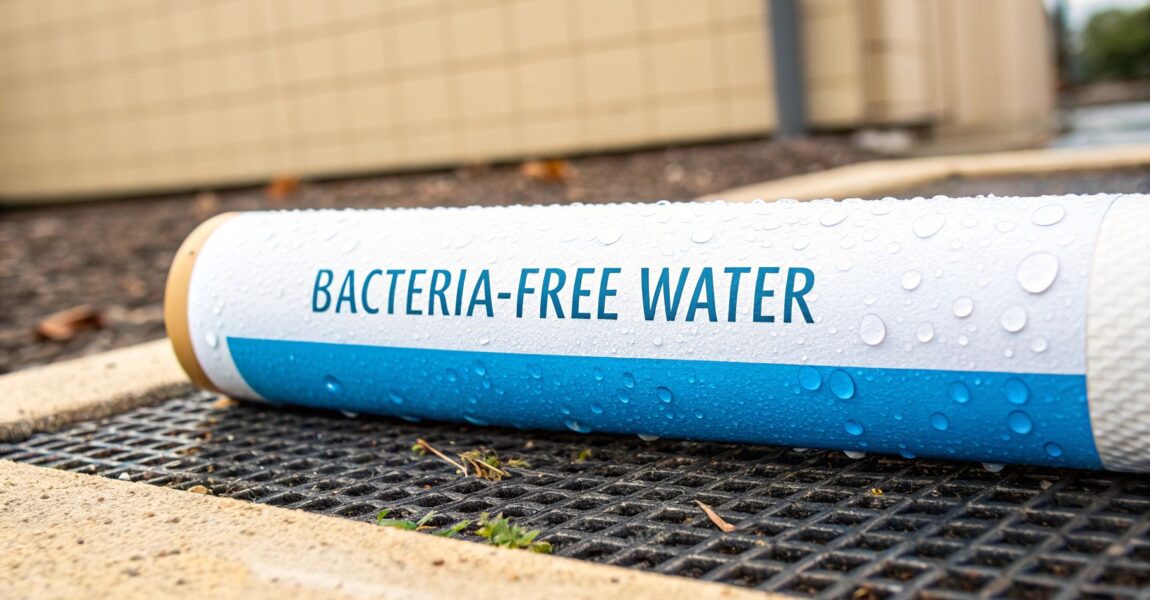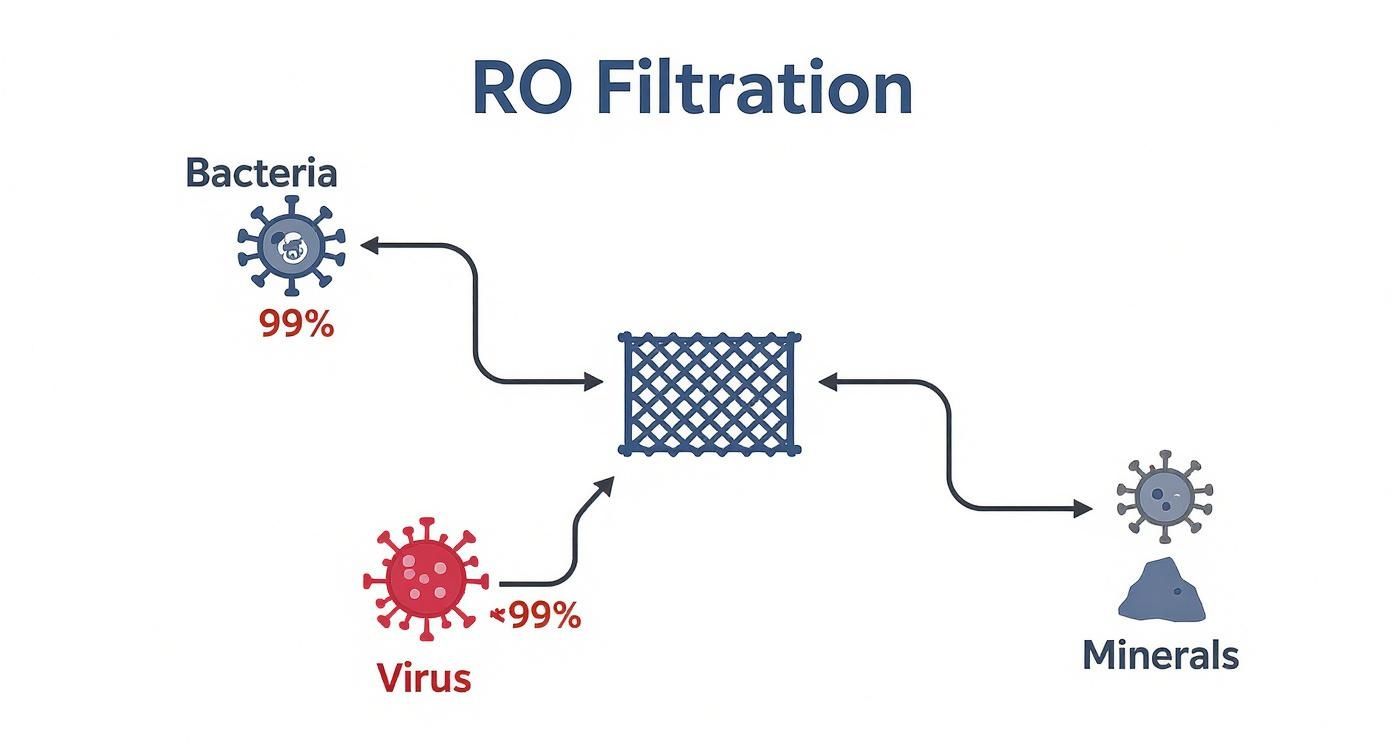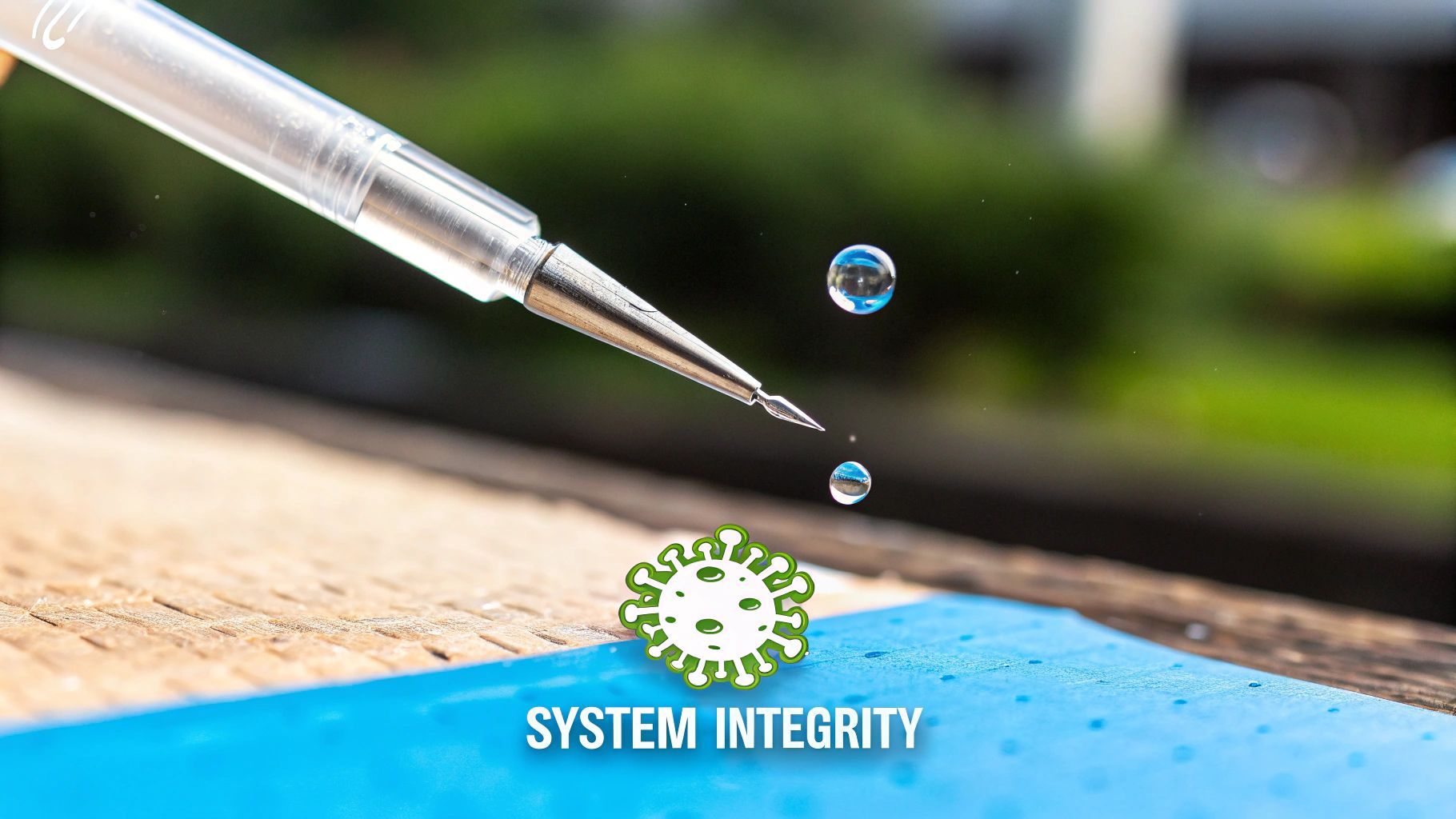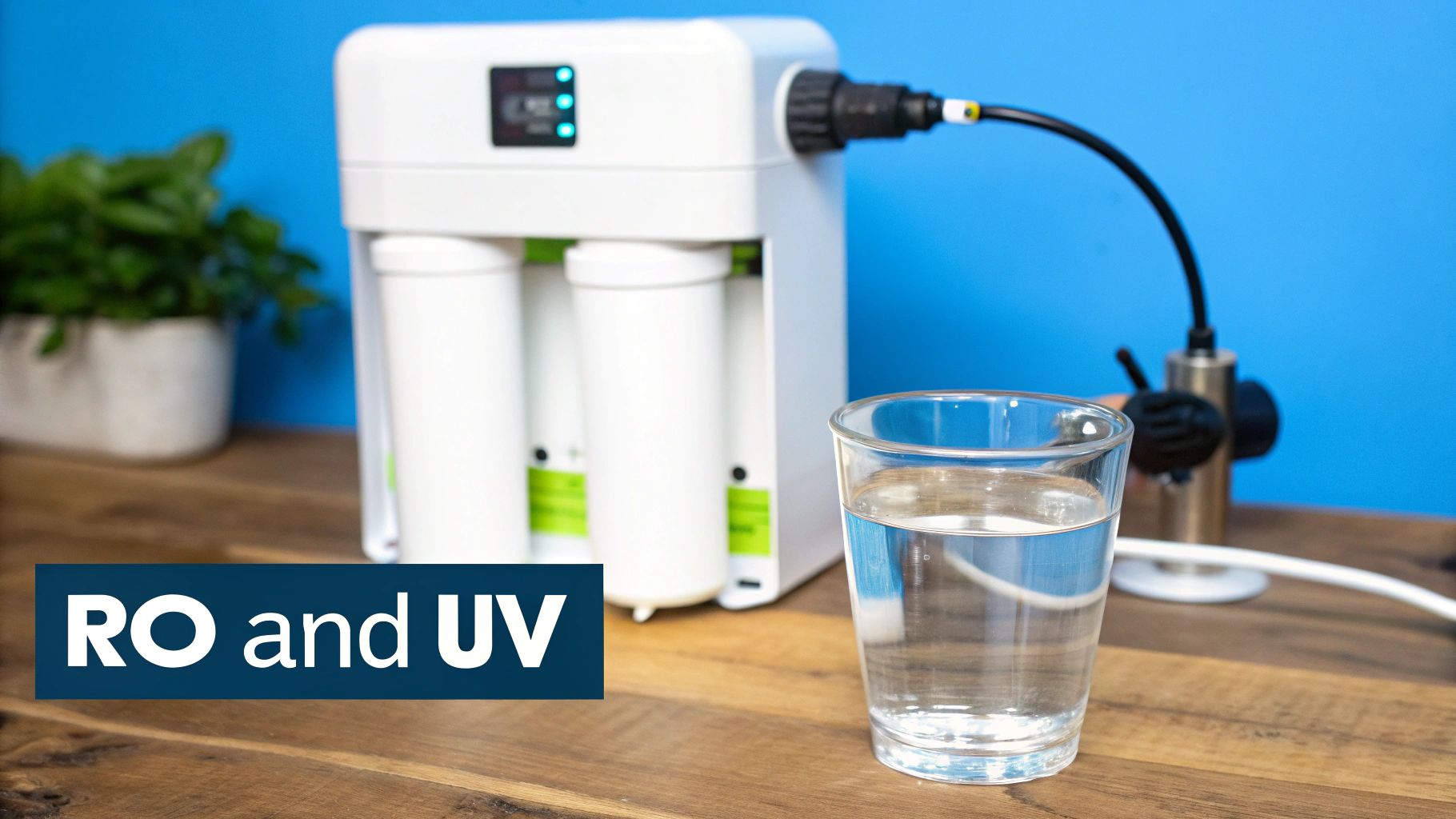
DIY Guide to Installing a Whole House Water Filter
Installing a whole house water filter is one of the best upgrades you can make for your home, providing clean, pure water from every single tap. Like any good home project, success starts with a solid plan. Before you even think about cutting a pipe, you need to nail down two things: the installation location and what kind of plumbing you're dealing with.
Getting this right from the start saves a ton of headaches and ensures your new water filtration system works like a charm for years to come.
Your Game Plan for Flawless Home Water Filtration
Ready to transform your home's water? This guide is your no-nonsense roadmap to installing a whole house water filter. Forget the technical jargon—we're here to give you clear, practical steps to seriously upgrade every drop of water in your home, from what you drink to what you shower in.

It’s no surprise these systems are becoming so popular. The home water filtration market is on a major upswing, projected to grow from USD 20.8 billion in 2025 to a massive USD 35.7 billion by 2035. Whole house units are a huge part of that because they treat water right where it enters your home, protecting you and your appliances.
Finding the Perfect Installation Spot
First things first, let's find the best home for your new filter. You’re looking for the spot where the main water line enters your house. This is usually in the basement, garage, or a utility closet.
The key is to install the filter before the main line splits off to your water heater or any other fixtures.
Why does this matter so much? By placing the filter at this "point of entry," you guarantee that every tap—hot and cold—delivers clean, filtered water. This is about more than just better-tasting water; it’s about protecting your entire plumbing system and every water-using appliance from sediment, chlorine, and other gunk.
When you're scouting locations, keep a few things in mind:
- Accessibility: You need room to work, but more importantly, you need space to change the filter cartridges down the road. I always recommend leaving at least a foot of clearance below the filter housing to make swapping filters easy.
- Drain Access: If your system has a backwashing feature, you'll need to run a line to a nearby drain. Plan for this now.
- A Solid Mount: These systems get heavy once they're full of water. Make sure you have a sturdy wall stud or a solid backer board to mount it to securely.
Identifying Your Pipe Type
Alright, next up is getting to know your plumbing. The material of your main water line will dictate the exact tools and fittings you'll need to buy. Take a good look at the pipe where you plan to make your cuts.
Pro Tip: Don't just guess your pipe size. Most homes have either 3/4-inch or 1-inch main lines. The size is often stamped right on the pipe or the existing fittings. Using the wrong size is the #1 cause of frustrating, slow leaks.
Here are the usual suspects you'll find in most homes:
- Copper: The classic. It's a rigid, reddish-brown metal pipe known for being incredibly durable.
- PEX: This is a flexible plastic tubing you'll see in a lot of newer homes. It’s usually red for hot water and blue for cold.
- PVC: A rigid plastic pipe, typically white or off-white. It's very common for main water lines coming into a house.
Taking the time to get this planning phase right is absolutely crucial for a smooth, leak-free installation. For more general tips and tricks on all things water filtration, check out the comprehensive advice available from our experts.
Getting Your Plumbing Ready for the Filter
Alright, you've got your plan and your shiny new filter. Now it's time to get your hands dirty. This is where the real work begins, and trust me, a bit of prep now will save you from a major headache (and a major mess) later.
Before you even think about cutting a pipe, you absolutely have to shut off the water to your entire house. This is non-negotiable. It’s the first rule of plumbing: take control of the water.
Find and Shut Off the Main Water Valve
First things first, you need to locate your home's main water shut-off valve. This is the master switch for all the water coming into your house. If you don't know where it is, don't sweat it—most people don't until they have to.
Here are the usual suspects for its location:
- In the basement, typically near the front wall where the water line enters.
- Tucked away in a utility closet or garage, often hanging out near the water heater.
- Outside in a buried service box near the street (this is the city's shutoff, but it works in a pinch).
Found it? Great. Turn the handle or wheel clockwise all the way until it stops. To be 100% sure the water is off, go open a faucet in your basement and another one in an upstairs bathroom. If the flow trickles to a stop, you're golden. This also has the added benefit of draining most of the water out of the pipes, which will prevent a surprise shower when you make your first cut.
Measure and Mark—Twice
With the water off and the pipes drained, it's time to mark your territory. This is the classic "measure twice, cut once" moment, and it really matters here.
Grab your filter housing and hold it up against the pipe where you plan to install it. You need to account for the total length of the filter and any other fittings you're adding, like shut-off valves or unions on each side.
Use a permanent marker to draw clear lines on the pipe showing exactly where to cut. I always suggest giving yourself a tiny bit of extra room between the marks. It's way easier to trim a pipe down a little more than it is to magically add a piece back on.
A rookie mistake I see all the time is measuring only for the filter body. Don't forget to add the length of your inlet and outlet fittings! Forgetting this turns a simple job into a frustrating jigsaw puzzle where the last piece doesn't fit.
Do Yourself a Favor: Build a Bypass Loop
Before you reach for the pipe cutters, let's talk about a pro move that your future self will thank you for: building a bypass loop.
A bypass is just a small section of parallel pipe with a valve that lets water go around the filter instead of through it. It might seem like extra work, but it's a total game-changer for maintenance down the road.
Think about it. When it's time to change the filter cartridge, you don't want to shut off water to the whole house just to do a five-minute job. With a bypass, you simply:
- Close the valves on the inlet and outlet of the filter.
- Open the valve on the bypass pipe.
- Swap out your filter without anyone in the house even knowing. The water keeps flowing.
It just takes a couple of extra T-fittings and one more ball valve, but the convenience is worth every penny. The core principles of creating secure, serviceable water lines are universal, whether on land or at sea; a solid setup requires good planning. For a deeper dive into the fundamentals, it can be helpful understanding boat plumbing systems, as many of the same concepts apply. Getting your plumbing prepped right is the foundation for a flawless installation.
Connecting Your Filter to Different Pipe Types
Alright, now we get to the fun part—actually tying the filter system into your home's plumbing. This is where the magic happens, and the right approach depends entirely on what kind of pipes you're working with. Don't sweat it; we'll walk through the most common types so you can handle this like a pro.
Once the pipe is prepped, you're ready to make the final connections. The first three steps are universal, no matter what kind of pipes you have.
You absolutely must shut the water off, drain the lines, and make your cut before doing anything else. It's a non-negotiable foundation for a safe, dry installation.
Working with Copper Pipes
Copper is the old standard in plumbing for a reason. You've got two solid options here, and your choice really boils down to traditional technique versus modern speed.
First up is sweat soldering. This is the classic plumber's method: use a torch to heat the pipe and fitting, then apply solder to create a permanent, bulletproof joint. It takes some practice, a torch, flux, and solder, but a well-soldered joint is second to none for reliability.
The other route, which is getting more popular by the day, is using push-to-connect fittings (think SharkBite). These things are a DIYer's best friend. You just clean up the end of the pipe, push the fitting on until it clicks, and you’ve got a watertight seal. They do cost more, but they can cut your installation time way down.
I’ve used both methods more times than I can count. My take? If you have the tools and know-how, soldering is rock-solid and cheap. For most homeowners, though, the speed and sheer simplicity of push-to-connect fittings are worth every extra penny for the peace of mind.
Tackling Threaded Galvanized Pipes
If you’re looking at older, silver-gray galvanized steel pipes, you'll be dealing with threaded connections. The secret here isn't brute force; it's all in the prep work. Old threads are often gunked up or corroded, and that will kill your seal.
Grab a wire brush and give the male threads a thorough cleaning. You want to see sharp, clean grooves. Once they're clean and dry, it's time for pipe thread sealant tape (you probably know it as Teflon tape).
Here's the right way to apply it:
- Wrap Clockwise: Always wrap the tape in the same direction you'll be tightening the fitting—clockwise. This keeps the tape from bunching up or unraveling.
- Don't Overdo It: 3-5 full wraps are usually perfect. Pull it snug so it settles into the threads.
- Skip the First Thread: Start your wrap on the second thread from the end. This prevents little bits of tape from shearing off and getting into your brand-new filter.
Once it's wrapped, thread the fitting on by hand, then give it a couple of final turns with a pipe wrench to make it snug.
Mastering PEX Tubing Connections
PEX, that flexible plastic tubing, is a staple in modern homes and is probably the easiest material to work with. You'll typically use either crimp or clamp connections, and both create a fantastic seal.
Crimp connections involve sliding a copper crimp ring over the PEX, inserting a barbed fitting, and then squeezing the ring with a special crimp tool. You’ll need a "go/no-go" gauge to double-check your work.
Clamp connections are very similar but use a stainless steel cinch clamp. A cinch clamp tool tightens a single tab on the clamp, which many people find a bit more forgiving.
Both methods require a dedicated tool, but they're incredibly fast and reliable, making them a great choice for a DIY filter install in a newer house.
The move towards these user-friendly connection methods is part of a bigger picture. The global water filter market is projected to grow from USD 48.2 billion in 2025 to USD 84.2 billion by 2032, largely because more people want clean water and are willing to install systems themselves. When dealing with PVC, a secure connection is just as critical; you might get some useful ideas from this guide on connecting a hose adapter to PVC.
Mounting the System and Making Final Connections
With your pipes prepped and waiting, it's time to give that filter a permanent home. Getting the mounting right isn't just about aesthetics; it’s about preventing long-term stress on your plumbing. A rock-solid installation also means changing the filter cartridge later is a simple task, not a frustrating wrestling match.

This step ensures the full weight of the unit—which gets surprisingly heavy once full of water—is supported by the wall itself, not your pipes. This stability is a huge part of installing a whole house water filter that will last for years.
Securing the Mounting Bracket
First things first, find a solid place to anchor this thing. Never mount a filter system directly to drywall. It simply won't hold the weight. Grab a stud finder and locate a wall stud right where you want to install it.
What if a stud isn't in the perfect spot? The pro move is to install a backer board. Just take a piece of 3/4-inch plywood and screw it securely across two studs. Now you’ve got a solid mounting surface anywhere you need it, giving you a ton of flexibility.
Hold the mounting bracket against the wall at your desired height. A good rule of thumb is to leave at least a foot of clearance below the housing. You'll thank yourself later when you have plenty of room to unscrew the sump for filter changes. Put a level on the bracket to make sure it's perfectly horizontal, then mark your drill holes with a pencil.
Drill some pilot holes into the stud or plywood, then drive in the lag screws that came with your kit. Give the bracket a good, firm tug to make sure it’s not going anywhere.
Hanging the Filter and Aligning Pipes
Now you can hang the main filter head assembly right onto the bracket. It should just slide or clip into place. With the head mounted, you can finalize the plumbing alignment.
Carefully bring your inlet and outlet pipes up to the filter's ports. This is where leaving a little extra pipe comes in handy. You want the pipes to meet the filter connections naturally, without you having to force or bend them into place.
Critical Check: Look closely at the filter head. You'll see arrows or labels marking "IN" and "OUT." This indicates the direction of water flow. Hooking it up backward is the most common DIY mistake, and it will keep the filter from working at all. Double-check this now. It’s a simple thing that can save you a massive headache.
Once everything is lined up perfectly, go ahead and make your final connections, whether that means tightening threaded fittings, soldering your copper, or snapping on push-to-connect fittings.
Your Final Pre-Flight Checklist
Before you even think about turning that main valve back on, stop and run through this quick list. This is your last chance to catch a small mistake before it turns into a big, wet problem.
- Bracket Security: Is the bracket totally solid? Give it another wiggle. No movement? Good.
- Filter Housing: Is the sump (the big canister part) hand-tightened onto the filter head? Don't use a wrench on it yet.
- Flow Direction: You checked it once, check it again. Is the "IN" pipe going to the "IN" port and "OUT" to "OUT"?
- Bypass Valves: If you installed a bypass, make sure the valves leading to the filter are OPEN and the main bypass valve is CLOSED.
- All Connections: Are all your fittings snug and tightened down properly?
Take a step back and admire your work. A good installation looks clean, professional, and feels solid. Once you've gone through this checklist, you’re ready for the moment of truth.
Commissioning Your System and Hunting for Leaks
This is the moment of truth. All your planning and hard work comes down to these next few minutes. The goal is a perfect, leak-free installation, and the key is patience.
How you reintroduce water to the system is the difference between a smooth finish and a frantic dash back to the shut-off valve.
https://www.youtube.com/embed/k_YdNIGuWD8
Head back to your main water shut-off and crack it open just a quarter turn. You’ll hear a gentle hiss as water starts to fill the pipes and filter housing. Don't be tempted to open it all the way just yet.
This slow trickle does two things: it prevents a damaging pressure surge called water hammer, and it gives you a crucial window to start hunting for leaks.
The Paper Towel Test
Now it’s time to play detective. Your best tool for this job is a simple, dry paper towel.
Go to every single connection you made—every fitting, joint, and valve on both the inlet and outlet sides of the filter. Touch the bottom of each one with the paper towel.
Even the smallest bead of moisture will show up immediately. Pay close attention to these spots:
- Where your pipes connect to the filter's inlet and outlet.
- Any unions or valves you installed, especially on a bypass loop.
- The main seal where the filter sump screws into the head.
If you find a drip, don't panic. Just shut the water off, drain the pressure, and fix it. A threaded fitting might just need another turn with the wrench or fresh plumber's tape. For a push-to-connect fitting, make sure the pipe is seated all the way in.
Once you're sure it's fixed, turn the water on slowly and test it again.
Purging Air and Flushing the System
With all your connections confirmed to be bone dry, you can open the main water valve completely. Your system is now under full pressure, but there's still air trapped inside that needs to get out.
Look for the small red or black pressure relief button on top of the filter housing. Press it down until the hissing stops and a steady little stream of water squirts out. That’s how you know the air is purged.
The final step is absolutely critical for water quality. New filter cartridges, especially carbon ones, are full of fine particles left over from manufacturing. Flushing them is not optional if you want clean, great-tasting water from the start.
Find the nearest cold water faucet—a utility sink or outdoor spigot works great—and turn it on full blast. Let it run for at least 10-15 minutes, or whatever your filter’s manual recommends.
The water might look cloudy or even dark at first. This is completely normal; it’s just harmless carbon fines washing out. Once the water runs crystal clear, your system is officially commissioned. You've successfully completed the process of installing a whole house water filter.
The demand for these systems is growing fast. The global household water purifier filter market is projected to expand by about USD 2.1 billion between 2025 and 2029, as more people seek cleaner water for their entire home. You can find more details in the latest market analysis from Technavio.
Common Questions About Whole House Filter Installation
Even with the best guide in front of you, it’s natural to have a few last-minute questions before you start cutting pipe. Let's tackle some of the most common things people ask right before they dive into installing a whole house water filter.
How Long Does a Filter Installation Take?
For a handy DIYer who's done some basic plumbing before, you can expect the job to take anywhere from 2 to 5 hours. Honestly, it all comes down to your specific setup.
If your main water line is sitting right out in the open in your garage and you're using push-to-connect fittings, you could be finished in a couple of hours. But if you’re sweating copper pipe, building a three-valve bypass, or working in a cramped crawl space, you should probably block off an entire afternoon.
A word of advice from experience: Rushing is what causes those tiny mistakes that turn into big, leaky headaches. A pro plumber can usually knock this out in 1 to 3 hours because they have all the right tools and have done it a hundred times.
What Are the Most Common Installation Mistakes?
I've seen my share of installations, and a few simple mistakes pop up over and over again. If you can avoid these, you're well on your way to a perfect, leak-free system.
- Installing the Filter Backward: Always—and I mean always—double-check the "IN" and "OUT" arrows on the filter head. It’s a simple thing, but getting it wrong means the filter won't do its job.
- Overtightening Plastic Fittings: It feels right to really crank down on plastic threads, but that's the fastest way to cause a hairline crack. Just remember the rule: hand-tight, then just a quarter-turn more with a wrench. That’s it.
- Forgetting About Future Maintenance: Don't box the filter into a corner. You need to leave enough room underneath it to unscrew the sump and change the cartridge later. A foot of clearance is a good rule of thumb.
- Sloppy Pipe Prep: This one gets a lot of people. If you don't clean, deburr, and completely dry the ends of your pipes before connecting them, you're asking for a slow, nagging drip that will drive you crazy trying to find later.
When Should I Hire a Professional Plumber?
Putting in a whole house filter is a great DIY project, but there are definitely times when calling a pro is the smart play. It’s not about giving up; it’s about protecting your home from water damage.
Think about hiring a licensed plumber if:
- The thought of cutting into your home's main water supply makes you break out in a cold sweat.
- You're dealing with old, fragile plumbing or pipes made of a material you don't recognize.
- You aren't 100% confident you can make a connection (especially a soldered one) that won't leak.
- Your local building codes require a licensed professional for any work on the main water line.
Paying for a pro buys you peace of mind, a warranty on the work, and insurance against the massive cost of a leak gone wrong.
How Often Do I Need to Change the Filter Cartridge?
That’s a great question, and there’s no single right answer. It really depends on the type of filter, your family's water usage, and just how "dirty" your incoming water is.
As a general guideline, here’s what you can expect:
- Basic Sediment Filters: These are your first line of defense for sand, silt, and rust. They usually need to be swapped out every 3-6 months.
- Carbon Block Filters: These bigger filters handle things like chlorine and chemicals and typically last 6-12 months. Many are also rated for a certain gallon capacity, like 100,000 gallons.
Your best bet is to start with the manufacturer's recommendation. But your house will tell you when it's time for a change. Look for two dead giveaways: a noticeable drop in water pressure at your faucets or the return of any tastes or smells the filter was getting rid of. If you spot either of those, it’s time for a new cartridge.
At Water Filter Advisor, our goal is to empower you with the knowledge to achieve safer, better-tasting water at home. Whether you're a DIY pro or just starting your research, we have the resources you need. Explore our in-depth guides and unbiased reviews at https://www.waterfilteradvisor.com.

